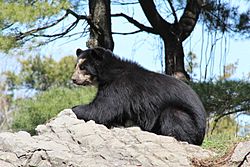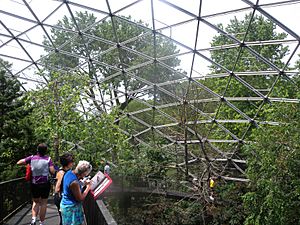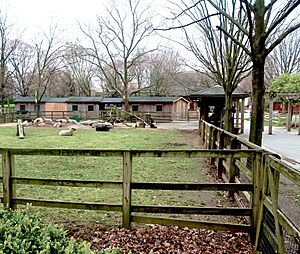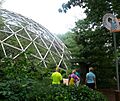Queens Zoo facts for kids

Andean bear female at the zoo
|
|
| Date opened | February 28, 1968 (children's farm) October 26, 1968 (rest of zoo) |
|---|---|
| Location | Queens, New York, United States |
| Land area | 11 acres (4.5 ha) |
| Coordinates | 40°44′42″N 73°50′54″W / 40.74500°N 73.84833°W |
| No. of species | 112 (as of 2013) |
| Memberships | AZA |
The Queens Zoo is a fun and educational place to visit in Flushing Meadows–Corona Park in Queens, New York City. It covers about 11 acres and is home to many amazing animals. The zoo is run by the Wildlife Conservation Society (WCS), a group dedicated to protecting wildlife. It's also approved by the Association of Zoos and Aquariums (AZA), which means it meets high standards for animal care.
The Queens Zoo first opened in 1968. It was originally called the Flushing Meadows Zoo. A special part of it, the Heckscher Children's Farm, opened a bit earlier. Unlike many zoos, the Queens Zoo focuses on animals that live in North and South America. Instead of cages, animals live in open-air habitats that look like their natural homes. This helps them feel more comfortable.
Contents
Exploring the Queens Zoo
The Queens Zoo is split into two main areas: the wild side and the domestic side. A path in Flushing Meadows–Corona Park separates these two parts. The zoo is open all year round, so you can visit any season!
The Wild Side: Animal Habitats
The wild side of the zoo is where you can see animals in large, natural-looking spaces. It covers about 11 acres. When the zoo was first built, it was designed so animals could roam freely. Instead of cages, there were dry moats and low fences around each animal's area. This design helps visitors feel closer to the animals.
After a big renovation in the 1990s, the wild side got even better. They added new homes for animals like Andean bears, bison, bobcats, coyotes, mountain lions, prairie dogs, and different kinds of birds. The animal habitats have cool hidden features, like rocks that are warmed up for the mountain lions. Zookeepers even hide food in tree trunks to make the animals search for it, just like they would in the wild.
There's a special path that winds around the wild side. You can find observation platforms that let you get a better view of the animals. There's also a "graveyard" with information about animals that are no longer alive, which helps visitors learn about conservation.
The Aviary: A Bird's Paradise
One of the most unique parts of the wild side is the aviary, a huge dome where birds fly freely. This dome was actually used during the 1964 World's Fair! It's 175 feet wide and was one of the biggest single-layer buildings of its time.
Inside the aviary, you'll find rocks, bushes, and trees, making it feel like a real forest. There's also a spiral bridge that lets you walk up high among the trees. Birds like guineafowl, mynas, peacocks, and quail used to live here. After the zoo reopened in 1992, the aviary was updated with native plants like white pine trees. The dome is covered with a special netting to keep the birds safe inside. By 2006, the aviary was home to 90 birds from 20 different species.
The Domestic Side: Farm Animals
On the western side of the zoo, you'll find the domestic side. This area was originally called the Heckscher Children's Farm and looks like an old American farm. It's a great place to meet friendly farm animals.
When it first opened, the children's farm had pigs, cows, sheep, donkeys, ponies, rabbits, and ducks. Many of these animals came from the Central Park Zoo. There was even a building that showed live insects, which was the only one of its kind in New York City back then. Today, the domestic side has a barn where you can learn about farm animals through educational programs.
Fun Activities and Events
The Queens Zoo hosts many exciting events throughout the year. You might find:
- Bison Bonanza: A festival with bison-themed activities, face painting, and storytelling.
- Fall Fun Festival: Seasonal activities for families.
- International Migratory Bird Day: Learn about birds that travel long distances.
- Winter Breakout: Special events during winter school breaks.
- International Harvest Festival: Celebrate the autumn harvest.
The zoo also offers classes and programs. High school students can even help with education and animal care! These programs are often available in different languages to welcome everyone.
Amazing Animals at the Zoo
The Queens Zoo is home to over 100 different animal species. All of them are native to North or South America. When the zoo first opened, it only had animals from North America. This was because the zoo is open all year, and the animals stay outdoors, so they needed to be able to handle the cold weather.
Today, the zoo has expanded to include animals from South America too, like the spectacled bears and American alligators. There's a small clinic at the zoo for animals that get sick or hurt. The zoo also has a special program called "animal enrichment" to make sure the animals stay happy and active.
Who Lives Here?
You can see many cool animals at the Queens Zoo, including:
- Andean bears
- Pumas (also known as mountain lions)
- California sea lions
- Coyotes
- Burrowing owls
- Canadian lynxes
- Southern pudus (small deer)
- Thick-billed parrots
- American alligators
- American bison
- Trumpeter swans
- Bald eagles
- Great horned owls
- Snowy owls
- Chacoan peccaries (pig-like animals)
Animal Reproduction and Conservation
The Queens Zoo is very involved in helping to save endangered animals. They have special breeding programs for several species:
- Andean Bears: The zoo helps breed these bears to protect their species. The first Andean bear cub was born here in 2017, and many more have been born since then!
- Southern Pudu: They have had a breeding program for these tiny deer since 2005.
- Pronghorn Antelopes: A breeding program for these fast animals started in 2008.
- New England Cottontail Rabbits: Since 2015, the zoo has helped breed these rabbits.
- Puerto Rican Crested Toads: They also have a program for these special toads.
Sometimes, animals that need help are rescued and brought to the Queens Zoo. For example, a coyote found in Central Park and some lion cubs rescued from Montana have found new homes here.
Images for kids
See also
 In Spanish: Zoológico de Queens para niños
In Spanish: Zoológico de Queens para niños





